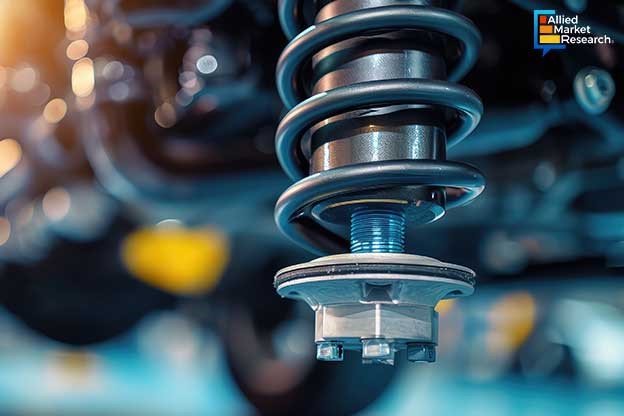Advancements in Automotive Suspension That Have Transformed the Automotive Domain

14 May
2024
Key Highlights
- Introduction
- Advancements in two-wheeler suspensions
- Latest trends in the automotive suspension sector
- Key developments in the industry
The automotive suspension industry has experienced a wave of innovation as advanced technologies are introduced to enhance comfort, handling, and safety for both drivers and passengers. Automakers constantly strive to improve their driving experience by integrating advanced features. Furthermore, the rise in popularity of electric vehicles has led to the development of innovative suspension systems designed specifically to meet the unique needs of these vehicles. As a result, the automotive suspension sector has evolved rapidly, offering many opportunities for the future of transportation.
Advancements in two-wheeler suspensions for comfort and safety
Two-wheeler manufacturers are increasingly adopting automotive suspensions due to their key role in improving comfort, stability, and safety during rides. These suspensions usually consist of shock absorbers and springs that reduce the impact of uneven road surfaces, resulting in smoother rides. Moreover, they enhance traction and control, which are essential for managing and boosting rider confidence, especially when turning corners or braking. This shift in the industry highlights the widespread recognition of the importance of suspension systems in enhancing the riding experience and fulfilling consumer demands for improved performance & comfort. Owing to these factors, the two-wheeler vehicle sector is anticipated to showcase notable growth with a CAGR of 5.2% by 2032.
Prominent automotive suspension trends transforming the outlook of the industry
Recent trends in the automotive suspension industry show a noticeable transition toward more advanced technologies and integrated systems designed to improve comfort and safety for both drivers and passengers. One prominent advancement is the rise of semi-autonomous suspension systems that utilize advanced sensors and actuators to automatically adjust damping rates and ride height based on road conditions. These systems offer a more comfortable driving experience and enhance the stability & handling of the vehicle.
Furthermore, there is a surge in focus on integrating other vehicle components, such as audio systems, backup cameras, electric systems, and sensors, to establish a seamless driving atmosphere. This integration ensures that passengers experience minimal disturbances from the road while benefiting from improved connectivity and convenience features. In addition to advancements in suspension technology, there is also a focus on offering extensive assistance for maintenance and repairs. This involves providing auto repair manuals and automotive diagnostic tools to aid mechanics and technicians in effectively troubleshooting and resolving issues.
Moreover, there is a surge in demand in the industry for premium suspension parts and components, along with specialized filters and fluids designed to enhance performance and durability. In addition, exterior accessories, such as suspension upgrades and automotive lighting upgrades, have become popular, which help drivers customize their vehicles as per their preferences and driving requirements. Hence, these trends show the industry's commitment to innovation and constant advancement in offering secure, comfortable, and pleasurable driving experiences.
Noteworthy growth of the Asia-Pacific automotive suspension sector
The Asia-Pacific automotive suspension domain has experienced notable growth due to rise in disposable income, increase in purchasing ability, transformations in lifestyle caused by rapid urbanization, and increase in knowledge of automotive suspension technology.
Moreover, the automotive suspension sector in Asia-Pacific is experiencing rapid expansion due to advancements in design, materials, and technology. In addition, the Asian region is expected to witness an increase in demand for luxury vehicles due to robust economic conditions and constant growth in the disposable income of the population. Among the developing countries in Asia-Pacific, India is anticipated to witness a remarkable CAGR of 6.3% during the forecast timeframe.
Strategic alliances by frontrunners to strengthen their position in the competitive industry
The leading players in the industry have formed strategic alliances such as collaborations, partnerships, and novel product launches to strengthen their position in the industry. For instance, in May 2023, Hitachi Ltd. announced the development of a novel active suspension system integrating artificial intelligence technology. This innovative system aims to enhance driving comfort and improve vehicle handling across diverse driving conditions.
To conclude, the global automotive suspension sector has experienced significant change due to advancements in technology, materials, and integration, catering to improved comfort, safety, and performance. Furthermore, innovations and collaborations offer lucrative growth opportunities that are expected to impact the transportation industry in the years to come.
For comprehensive insights into the global automotive suspension industry with future estimations, contact our experts here!

Koyel Ghosh
Author’s Bio- Koyel Ghosh is a blogger with a strong passion and enjoys writing in miscellaneous domains, as she believes it lets her explore a wide variety of niches. She has an innate interest in creativity and enjoys experimenting with different writing styles. A writer who never stops imagining, she has been serving the corporate industry for the last five years.
How Have Innovations in Food Logistics Improved the Revenue Share of the Food & Beverages Domain?
Avenue: Entire Library membership of Allied Market Research Reports at your disposal
- Avenue is an innovative subscription-based online report database.
- Avail an online access to the entire library of syndicated reports on more than 2,000 niche industries and company profiles on more than 12,000 firms across 11 domains.
- A cost-effective model tailored for entrepreneurs, investors, and students & researchers at universities.
- Request customizations, suggest new reports, and avail analyst support as per your requirements.
- Get an access to the library of reports at any time from any device and anywhere.
Related Post
-
How are Submarine Cables Transforming Global Connectivity with Enhanced User Experience?
-
Endoscopy Procedures: Transformations in Techniques and Applications
-
AI-Powered Video Analytics: How the Product Actually Works for enterprises
-
Painting Robots: Transforming Precision Coating and Creative Applications
-
Innovations in Pharmacovigilance Systems Advancing Patient Safety
-
Understanding Edge Security: Keeping Data Safe Near the Source
-
Exploring the Use and Advancements of 3D Laser Scanners in Professional Applications
-
Reinforcing Industrial Controls with Smarter Tools and Training








